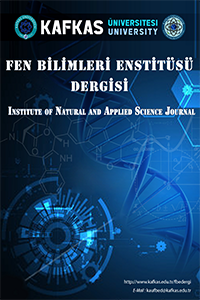Redoks Polimerizasyonu ile Epoksi Reçine İçeren Poli(GMA-b-EG) Blok Kopolimerinin Sentezi ve Karakterizasyonu
Epoksi bazlı blok kopolimer, glisidil metakrilat, redoks polimerizasyonu, polietilen glikol, dispersite.
Synthesis and characterization of the poly(GMA-b-EG) block copolymer containing epoxy-resin by redox polymerization
Epoxy-based block copolymer; glycidyl methacrylate, redox polymerization, polyethylene glycol, dispersity.,
___
- B Hazer., Çakmak İ., Denizligil S., Yağcı Y. (1992). Preparation of multiphase block copolymers by redox polymerization. Angew. Macromol. Chem, 195(1), 121-127.
- Chen J. (2008). Molecular Recognition in Terms of a Dimensionless Index. 2. Thermodinamic Patterns of Intromolecular Interactions of PEG and Its Alcohol Substrates. Journal of Physical Chemistry, 112(6) 1706-1711.
- Cakmak I. (1995). Synthesis of block copolymers by redox macro initiators. Macromol Rep. 32(1) 197-206.
- Çakmak I. (1993). Preparation of multiphase block copolymers by redox polymerization process. 2: Polymerization of acrylonitrile by the manganese(III)-poly(ethylene glycol) redox system. Die Angew. Macromol. Chem. 211(1), 53-60.
- Göktaş M., Öztürk T., Atalar M.N., Tekeş A.T., Hazer B. (2014). One-Step Synthesis of Triblock Copolymers via Simultaneous Reversible-Addition Fragmentation Chain Transfer (RAFT) and Ring-Opening Polymerization Using a Novel Difunctional Macro-RAFT Agent Based on Polyethylene Glycol. J. Macromol. Sci. Part A-Pure and Appl. Chem. 51(11), 854-863.
- Göktaş M. (2019). Synthesis and characterization of various block copolymers using PMMA-Br macroinitiator. Chem. Papers, 73(9), 2329–2339,
- Göktaş M. (2020). Synthesis and characterization of temperature-responsive block copolymers using macromonomeric initiator. Chem. Papers, 74(7), 2297–2307.
- Göktaş M., Deng G. (2018). Synthesis of Poly(methyl methacrylate)-b-poly(N-isopropylacrylamide) Block Copolymer by Redox Polymerization and Atom Transfer Radical Polymerization. Indones. J. Chem. 18(3), 537–543.
- Göktaş M., Aykaç C. (2020). Synthesis and characterization of poly(ε-caprolactone)-b-poly(acrylamide) block copolymers. J. Inst. Sci & Tech. 10(2), 1154-1162.
- Göktaş M., Olgun B. (2019). One-step synthesis and characterization of poly(ԑ-caprolactone)-b-poly(N-isopropylacrylamide) thermo-responsive block copolymers via RAFT and ROP techniques. Polym. Sci. Series B. 61(4), 421–429.
- Göktaş M. (2019). Synthesis and characterization of poly (styrene-b-methyl methacrylate) block copolymers via ATRP and RAFT. J. Inst. Sci & Tech. 9(1), 139-149.
- Klimow V.V., Kolyaganova O.V., Bryuzgin E.V., Navrotsky A.V., Novakov İ.A. (2022) Effect of the Composition of Copolymers Based on Glycidyl Methacrylate and Fluoroalkyl Methacrylates on the Free Energy and Lyophilic Properties of the Modified Surface. Polymers, 14, 1960.
- Kovar J., Navratilova M., Skursky L. (1982) Immobilization of horse liver alcohol dehydrogenase on copolymers of glycidyl methacrylate and ethylene dimethacrylate. Biotechnol. Bioeng. 24, 837–45.
- Li J., and Kao W. J. (2003). Synthesis of Polyethylene Glycol (PEG) Derivatives and PEGylated-Peptide Biopolymer Conjugates. Biomacromolecules, 4(4), 1055-1067.
- Liu X., Hou G., Zheng H., Li W. (2022) Preparation of Wool-g-Glycidyl Methacrylate with a Constructed –SH Groups/Ammonium Persulfate Redox System and Characterization. MATERIALS SCIENCE (MEDŽIAGOTYRA), 28 (3).
- Matt L., Liblikas I., Bonjour O., Jannasch P., Vares L. (2021). Synthesis and anionic polymerization of isosorbide mono-epoxides for linear biobased polyethers. Polym. Chem. 12(41), 5937–5941.
- May C.A. (1988). Epoxy resins chemistry and technology. New York: Marcel Dekker.
- Muzammil E. M., Khan A., Stuparu M.C. (2017). Post-polymerization modification reactions of poly(glycidyl methacrylate)s. RSC Adv. 88 (7) 55874–55884.
- Öztürk T., Göktaş M., Hazer B. (2011). Synthesis and Characterization of Poly(methyl methacrylate-blockethylene glycol-block-methyl methacrylate) Block Copolymers by Reversible Addition-Fragmentation Chain Transfer Polymerization. J. Macromol. Sci. Part A-Pure and Appl. Chem. 48(1), 65-70.
- Öztürk T., Çakmak İ. (2007). Synthesis of Block Copolymers via Redox Polymerization Process: A Critical Review. Iranian Polym. J. 16(8), 561-581.
- Öztürk T., Göktaş M., Hazer B. (2010). One-Step Synthesis of Triarm Block Copolymers via Simultaneous Reversible-Addition Fragmentation Chain Transfer and Ring-Opening Polymerization. J. Appl. Polym. Sci. 117(12), 1638–1645.
- Öztürk T., Kayğın O., Göktaş M., Hazer B. (2016). Synthesis and Characterization of Graft Copolymers Based on Polyepichlorohydrin via Reversible Addition-Fragmentation Chain Transfer Polymerization. J. Macromol. Sci. Part A-Pure and Appl. Chem. 53(6), 362–367.
- Öztürk T., Yavuz M., Göktaş M., Hazer B. (2016). One-step synthesis of triarm block copolymers by simultaneous atom transfer radical and ring-opening polymerization. Polym. Bull. 73(6), 1497–1513.
- Öztürk T., Atalar M.N., M Göktaş., B Hazer. (2013). One-Step Synthesis of Block Graft Copolymers via Simultaneous Reversible-Addition Fragmentation Chain Transfer and Ring-Opening Polymerization Using a Novel Macroinitiator. J. Polym. Sci. Part A Polym. Chem. 51(12), 2651–2659.
- Waly A.İ., Khedr M.A.M., Ali H.M., Ahmed İ.M. (2020) Chemical Functionalization of Cellulose-Poly(Glycidyl- Methacrylate) Graft Copolymer with Two Different Poly Amino Compounds. Egypt J Chem. 63 (7) 2673 – 2682.
- Wang B., Wang P., He B., Liu S., Ye Q., Zhou F. (2022) Fabrication of ionic liquid-functionalized polystyrene nanospheres via subsurface-initiated atom transfer radical polymerization for anti-fouling application. Progress in Organic Coatings 171, 107044.
- Wei Wang W., Hutchinson R.A. (2008). PLP/SEC/NMR Study of Free Radical Copolymerization of Styrene and Glycidyl Methacrylate. Macromolecules, 41(23), 9011-9018.
- Yılmaz S., Coşkun M. (2018). Poly(glycidyl methacrylate-co-styrene): Synthesis, Characterization, Reaction With Aminated MWCNT and Thermal investigation. El-Cezerî Journal of Science and Engineering, 5(2) 537-546.
- Zhou S. (2003). Biodegradable poly(e-caprolactone)-poly(ethylene glycol) block copolymers: characterization and their use as drug carriers for a controlled delivery system. Biomaterials, 24(20), 3563-3570.
- ISSN: 2587-2389
- Yayın Aralığı: Yılda 2 Sayı
- Başlangıç: 2008
- Yayıncı: Kafkas Üniversitesi
Katı Yakıtların Şişme Özelliklerinin İncelenmesi ve Sıvılaştırılması
Ahmet Turan TEKEŞ, Aslıhan Aycan TANRIVERDİ, Ahmet Muammer CANEL
İlköğretim Matematik Öğretmeni Adaylarının Bakış Açısından “Örnekler”
Ortaokul Öğrencilerinin Sosyal Ağ Kullanım Analizi: Kars İli Örneği
Ezgi Pelin YILDIZ, Duygu UÇUM YİĞİT
Çelik Malzeme Yüzeyinde Farklı Lazer Güçlerinin Etkisinin İncelenmesi
